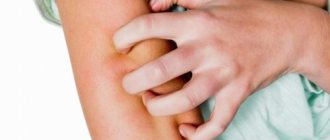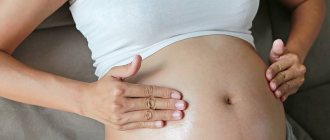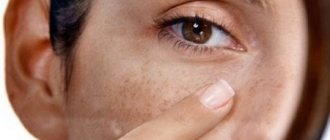Why do skin rashes occur?
Rash in pregnant women can appear for a variety of reasons. Sometimes rashes occur due to pregnancy itself, due to numerous changes in all organs and systems. Such conditions are combined into the group of dermatoses of pregnancy. But in addition, a rash on the skin of an expectant mother can appear for the same reasons as in non-pregnant women, for example, due to:
- Allergic diseases.
- Increased sweating.
- Acne disease.
- Skin parasites.
- Skin infections.
- Psoriasis.
- Systemic infectious diseases, for example, chickenpox, rubella, etc.
- Pathologies of blood and blood vessels, etc.
It is worth noting that any skin rash during pregnancy is a reason for an immediate visit to the doctor. If the rash is accompanied by a deterioration in the general condition, it would be a good idea to call an ambulance.
In the early stages
Most rashes on the skin of a pregnant woman that appear in the early stages are associated with hormonal changes in the body and a natural decrease in immunity. During this period of time, expectant mothers may suffer from:
- Acne rashes.
- Various skin diseases, including infectious ones. Such diseases often make themselves felt against the backdrop of a decrease in the body’s defenses.
In the later stages
When pregnancy crosses the equator, conditions associated with this interesting position are more common:
- Various types of dermatoses during pregnancy.
- Prickly heat. In the later stages, the risk of developing such a disease is especially high, since the pregnant woman’s body weight increases and sweating increases.
Various pathological types of rashes caused by systemic diseases can occur at different stages of pregnancy with the same degree of probability.
How to treat allergies during pregnancy
Treatment of allergies in pregnant women is quite varied. Below we will describe what you can take to get rid of the main symptoms of allergies.
Remember that the main task of drugs during this exciting period is to safely and effectively eliminate allergic symptoms without the risk of negative effects on the fetus. Medicines should be used with extreme caution and only as prescribed by a doctor.
Treatment of allergies during pregnancy in the 1st trimester
It is not advisable to use any medications during this period.
If you are allergic to flowers, it is advisable to wash your clothes and shoes after each walk. If it is impossible to avoid contact with the allergen, you should wear a medical mask.
For allergic rhinitis
Nasal drops, which are used for a common runny nose, help well with allergic rhinitis.
Products containing sea salt are considered the best for pregnant women.
Among them:
- Drops Marimer and Aqua Maris ;
- Complex “Dolphin” with sea salt and herbs;
- Spray Doctor Theiss Allergol sea water
In addition to the above, you can use:
- Pinosol - contains extracts of mint and eucalyptus, which improve well-being in case of allergic rhinitis.
- Prevalin spray - forms a thin foam on the mucous membrane, blocking allergens.
- Salin drops - the main active ingredient is sodium chloride. Helps cleanse the nasal cavity.
Conjunctivitis, lacrimation
Innoxa blue drops , which contain only natural substances, are suitable for washing the eyes.
Itching, rash, peeling
Photo: Zinc ointment (photo enlarges by clicking)
Ointments are a good remedy; they will help get rid of skin allergies during pregnancy - rashes, skin dermatitis. For example, zinc ointment has a pronounced drying effect.
Similarly, you can use a Tsindol containing zinc oxide.
A good option is creams that contain extracts of medicinal plants. of Physiogel AI to the affected areas helps.
Before use, be sure to perform an allergy test on a small area of skin. If redness does not appear, the drug can be used
Food and drug allergies - body cleansing
This type of allergy is most often characterized by hives and other skin rashes. The first step is to eliminate the allergen from consumption, and then cleanse the body. This will help:
- Lactofiltrum;
- Enterosgel.
In case of severe allergies, accompanied by itching or flaking, in the first days you should take a double dose of any sorbent, for example, activated carbon.
The dose is calculated as follows:
1 tablet per 5 kg of person’s weight.
How to easily calculate: divide your weight by 5. This will be the number of tablets.
Use 2-3 times a day for 1-2 days. Then the usual dose returns - 1 tablet per 10 kg of body weight.
Can I take allergy pills during pregnancy?
What allergy pills can pregnant women take? — The answer to the question can only be given by the attending physician
As for antihistamines, unfortunately, there are no drugs that are completely safe for a pregnant woman. Let's consider how to treat allergies during pregnancy, which antihistamines can be used during this period on the recommendation of the attending physician, and which are completely prohibited.
You should take into account the indications and contraindications of antihistamines in order to choose the right way to treat allergies in pregnant women, especially in severe cases.
Attention!
You should only take medications prescribed by a doctor, since many medications can negatively affect the course of pregnancy and the process of fetal development, and a specialist is able, based on all the data collected during the diagnostic process, to prescribe a safe and effective course of treatment.
H1-histamine blockers
They block histamine receptors, thus eliminating the symptoms of an allergic reaction. There are 4 generations of these drugs, where each subsequent one is characterized by fewer side effects and the strength of their manifestation, and a longer effect. Listed below are the main tablets of category H1 and the possibility of their use in different trimesters of pregnancy.
1st generation
- Diphenhydramine . Strictly contraindicated throughout pregnancy, since it affects the contractility of the uterus when taken in a dose of more than 50 mg. In extreme cases, it can only be used in the 2nd trimester.
- Suprastin . This drug is contraindicated during pregnancy, although there is no reliable information about its effect on the fetus. The drug is not prescribed in the first trimester of pregnancy and in later stages.
- Tavegil . The drug is used only in cases of emergency, when it is not possible to use another remedy. The drug is not used in the first trimester. Experiments on animals have shown the presence of malformations in the fetus.
- Pipolfen (piperacillin, diprazine). There are no clinical data on the use of this drug, therefore its use is contraindicated. If it is necessary to take drugs during lactation, it should be discontinued.
2nd generation
- Claritin . No negative effects on the fetus and the maternal body have been identified, but at the same time, the reaction of a pregnant woman to the drug can be unpredictable. It is for this reason that Claritin is prescribed to a pregnant woman only as a last resort.
- Terfenadine . Undesirable during pregnancy, may lead to weight loss in the newborn. Used if the effect of use outweighs the risk to the fetus.
3rd generation
- Fexadin . These allergy pills are contraindicated during pregnancy.
- Zyrtec (also known as cetirizine). A teratogenic effect from the use of the drug has not been identified, but it can pass into breast milk.
- Allertek - can be used in the 2nd and 3rd trimesters as prescribed by a doctor
Corticosteroids
Available in the form of tablets, injections, as well as ointments and creams. The mechanism of action of corticosteroids is based on the inhibition of Th-2 cytokines, “responsible” for the occurrence of an allergic reaction.
It has been established that the use of drugs such as Dexamethasone, Metypred significantly reduces the female body’s resistance to various infections, and therefore also negatively affects the fetus. That is why corticosteroids are prescribed to a pregnant woman if traditional antiallergic drugs do not give the desired effect.
Dermatoses of pregnant women
Dermatoses of pregnant women are a whole group of diseases characterized by specific changes in the condition of the skin. Such ailments occur only in expectant mothers; they do not occur in non-pregnant mothers. Most often, they do not require targeted therapy and go away well over time, but there are some exceptions. Dermatoses of pregnant women include 4 conditions:
- Atopic dermatitis of pregnancy.
- Polymorphic dermatosis of pregnant women.
- Pemphigoid of pregnancy.
- Intrahepatic cholestasis of pregnancy.
Doctors associate the occurrence of dermatoses in pregnant women with a natural shift in the balance of the immune system, due to which skin cells are particularly sensitive to various environmental factors, as well as to all kinds of substances synthesized by the body of the expectant mother. As a rule, such conditions appear in the third trimester, but sometimes they occur earlier.
To date, the topic of dermatoses in pregnant women has not yet been well studied, so many doctors find it difficult to diagnose and treat such conditions. In the best case, patients are diagnosed with pregnancy itch, and in the worst case, doctors identify and stubbornly treat false diseases.
Atopic dermatitis
This condition accounts for approximately half of the cases of dermatosis in pregnant women. Atopic dermatitis in expectant mothers can occur in three different types:
- Eczema of pregnancy. This condition usually manifests itself quite atypically. The affected areas on the body can be localized in the neck, on the arms and legs of pregnant women, as well as on the palms, soles and face; they itch noticeably. Their appearance is often associated with mechanical injuries or fungal infections, while during a blood test a woman may be diagnosed with an increase in IgE antibodies. It is believed that the presence of eczema in pregnancy warns of a high susceptibility to atopic dermatitis. Rashes on the body can appear at the beginning of pregnancy, including in the first trimester. Dermatosis does not pose any threat to the fetus, but can be treated with various local symptomatic medications to eliminate discomfort.
- Purigo of pregnant women. This is a rarer condition, which is characterized by the appearance of itchy rashes on the body that look like small nodules - papules. Most often they concentrate on the arms and belly of the expectant mother. Purigo can appear at any stage of pregnancy; it does not pose any threat to the health of the woman and her child.
- Itchy folliculitis of pregnancy. This condition occurs even less frequently during pregnancy. It can appear in the second or third trimester (but not always) and is accompanied by the appearance on the body of a significant number of itchy nodules, ranging in size from 2 to 4 mm. Rashes can appear on different parts of the body; typical locations are the shoulders, back and chest. Sometimes nodules are found on the abdomen. Externally, itchy folliculitis looks like a bacterial rash, but does not pose any threat to the expectant mother and her child. Histological examination of the rash shows the absence of pathogenic pathogens.
Typically, treatment of atopic dermatitis in pregnant women does not produce a positive effect. Signs of this condition disappear on their own - during pregnancy or after childbirth.
Polymorphic dermatosis on the abdomen
This dermatosis of pregnant women is manifested by the appearance of rashes of various types and is considered quite common. According to statistics, this condition is more often observed during repeated pregnancies, and risk factors for its occurrence include excess weight and multiple pregnancies. Polymorphic dermatosis usually makes itself felt in the third trimester of pregnancy, and in rare cases, such a pathology develops even after childbirth, which significantly complicates diagnosis. This type of dermatosis is characterized by:
- The appearance of various types of rashes on the skin - nodules, plaques, and blisters.
- The rash is initially localized on the abdomen (except for the navel area) and stretch marks; later, elements of the rash can spread to the chest, thighs, and arms. In this case, the rash rarely affects the mucous membranes, palms and soles.
- Spontaneous disappearance shortly before birth (not in 100% of cases).
Like other types of dermatoses of pregnant women, polymorphic dermatosis does not pose any threat to the expectant mother and her child. This condition extremely rarely requires symptomatic treatment, as it mostly causes aesthetic discomfort.
Pemphigoid
This is an extremely rare disease, which was previously often called pregnancy herpes due to the similarity of the skin rashes with the manifestations of herpes. However, this condition is not provoked by herpes viruses; doctors suggest that its occurrence is associated with the presence of autoimmune disorders. According to statistics, pemphigoid in pregnant women is more often diagnosed in women suffering from some autoimmune diseases. This condition is characterized by:
- The appearance of papules and plaques in the navel area.
- The rash spreads to the chest, back, and thighs and arms (not always). Possible damage to mucous membranes.
- Transformation of rash elements into bubbles.
Pemphigoid of pregnancy is characterized by the production of IgG antibodies, which are able to penetrate the placenta. About 5% of women with this pathology give birth to children with a variety of rashes. This condition also increases the risk of premature birth and the birth of low birth weight babies.
Pemphigoid of pregnancy usually does not require treatment. The disease may subside towards the end of the third trimester, but there are cases when it worsens during childbirth.
Intrahepatic cholestasis
This condition is most often classified as itching of pregnancy, and is extremely rarely accompanied by rashes. The disease begins with itching, most often on the palms and soles, which spreads to other parts of the body. The discomfort can be so strong that a woman involuntarily scratches her skin.
Intrahepatic cholestasis is sometimes accompanied by an increase in the level of bile acids and liver tests, and if such indicators increase critically, this poses a threat to the health and even life of the fetus.
Are there any without itching?
In almost 100% of cases, dermatoses of pregnant women are accompanied by itching sensations of varying severity. Therefore, rashes that do not itch most likely have a different origin.
Expectant mothers who have discovered rashes on their bodies are strongly advised not to guess what exactly they are, but to seek advice from a doctor.
Enemy No. 1 – infection
Of course, when a rash appears on the abdomen in pregnant women, some kind of infection . After all, everything is very simple: you can lie down lightly on a couch in a clinic or inpatient department and get scabies or something like that.
Various types of infectious diseases can cause rashes in different parts of the pregnant woman's body. But in any case, it will start from the stomach .
Therefore, if a rash appears and you suspect an infection, it is better to immediately consult a doctor . He will help determine the cause of the infection and prescribe adequate treatment to combat it.
When do they go on maternity leave? You will learn about this here.
This section contains a lot of useful information that you need to know when planning a pregnancy.
Prickly heat
Miliaria is a skin disease that occurs due to increased sweating. As a rule, this disease is diagnosed in infants; adults encounter it quite rarely. But in expectant mothers, its development can be facilitated by increased sweating and changes in the composition of sweat (due to natural changes occurring in the body). Miliaria most often occurs on the body during the hot season, when wearing tight, uncomfortable or too warm clothes made of synthetic fabrics. Weight gain increases the risk of developing this disease. Miliaria can occur in three different forms:
- Crystalline. In such a situation, small white or pearlescent bubbles no larger than 2 mm in size appear on the skin, which do not itch and burst easily. The skin after them becomes flaky and irritated. The affected areas are localized on the torso.
- Deep. This prickly heat looks like flesh-colored bubbles up to 3 mm in size. They are localized on the skin of the extremities, as well as the torso. The main reason for their occurrence is overheating.
- Red. This rash looks like small, uniform blisters or nodules that are found on reddened skin and itch painfully. This type of heat rash usually appears in skin folds, including on and under the chest (after all, during pregnancy, sweat accumulates in this area and friction increases). Also, rashes may appear in places where there is pressure from clothing.
Miliaria usually does not pose any threat to health and goes away quickly, you just need to normalize thermoregulation and skin care. But elements of rashes in such a disease can become an entry point for infection.
Skin rash in early and late pregnancy: causes
Let's start with the fact that skin rashes during pregnancy are a common phenomenon. Therefore, there is no need to panic in such a situation. But trying to figure out what caused the skin rashes is not only possible, but also necessary.
Most often, a skin rash in a pregnant woman appears under the influence of hormonal changes. However, the causes of rashes can be not only physiological, but also indicate the development of a serious pathology that threatens the health of the mother and fetus. Let's find out what a skin rash that appears in the early and late stages of pregnancy may indicate.
The first reason is dermatosis
This pathology most often appears due to hormonal changes in the body of a pregnant woman in the last trimester. Symptoms of dermatosis are rashes in the form of nodules and plaques in the area of stretch marks on the abdomen and thighs. Subsequently, elements of the rash can merge, forming large plaques that spread and appear on the buttocks, chest, legs and back.
After childbirth, as a rule, pimples disappear. Hormonal rash does not pose any particular danger to women and babies.
The second reason is rubella
This disease is dangerous during pregnancy because it has a detrimental effect on the fetus. If rubella appears in the first trimester, it can cause the unborn child to develop cataracts, deafness, heart defects, and damage to the nervous system. Therefore, if a woman is diagnosed with rubella in the first trimester, the pregnancy is usually terminated.
Symptoms of the disease are a small pale pink rash all over the body, headache, nausea, and fever.
Reason three - measles
The disease develops in the absence of immunity to it. Measles suffered in the first trimester can cause dementia and other pathologies of the nervous system in the child. Symptoms of the disease are rashes in the form of tubercles, which first affect the neck and face, then the torso and arms, and then the legs.
Having measles in the first trimester of pregnancy is a reason to terminate it.
Reason four - herpes
Herpetic infection most often causes congenital diseases of the fetus.
With primary infection with herpes during pregnancy, the probability of infection of the child is 50%; with an exacerbation of an existing disease, the risk is significantly reduced - to 4%. Herpes is transmitted sexually, through kissing and household items. Symptoms: small red rash with blisters filled with clear liquid. The disease is accompanied by burning, redness and itching. After a while, the blisters burst, forming ulcers. In the first trimester of pregnancy, this pathology can cause mental retardation and diseases of the cardiovascular system of the fetus. Infection with this virus in the third trimester often leads to the development of encephalitis, hepatitis, pneumonia and other pathologies.
Reason five - chickenpox
This disease poses the greatest danger in the first and last trimester of pregnancy, as it can cause miscarriage or severe malformations of the baby. Chickenpox suffered in the third trimester leads to intrauterine infection, pneumonia and oxygen starvation.
Symptoms of the pathology are rashes in the form of pink spots on which bubbles with clear liquid form. Later they become covered with crusts. With chickenpox, not only the rash, but also severe itching is annoying.
Reason six - scabies
Symptoms of this disease are blisters and bumps on the skin, which most often appear between the fingers and toes in the form of scabies. Such rashes itch unbearably. Fortunately, this pathology does not pose a danger to the mother and child.
Reason seven - allergies
One of the most common causes of an allergic rash during pregnancy is a special reaction of the body to a substance (allergen). The rash looks like small blisters with clear contents or spreads throughout the body in large spots.
Allergy
Allergic diseases during pregnancy worsen very often, and many women encounter the problem of allergies for the first time during pregnancy. Such reactions do not always manifest themselves on the skin; sometimes they cause respiratory disorders or systemic symptoms. The most typical dermatological manifestations of allergies:
- Hives. When this condition develops, profuse rashes suddenly appear on the skin, which are very itchy. They appear soon after contact with the allergen, and then disappear without a trace. The rashes look like blisters, similar to marks from a nettle burn.
- Allergic dermatitis. In this situation, the skin becomes covered with areas of peeling, dries out and itches a little. A small nodular rash may appear in some places.
In the absence of adequate and timely correction, allergies can lead to more serious skin lesions and also become the cause of systemic allergic reactions that are dangerous for both the pregnant woman and her child.
Nature of the disease
It is unlikely that it will be possible to accurately establish the allergic nature of the rash and redness on the abdomen without the help of specialists. The cause, in addition to allergies, can be dermatosis, prickly heat, infectious diseases, and stress. Therefore, it is important to determine the specific nature of the disease, to establish its true causes in order to cope with them faster. An incorrect diagnosis can make the situation worse.
Red rashes, as in the photo, may appear for the first time during pregnancy. This is because the body is sensitive to internal and external factors. Urticaria, rash, dermatitis occur in pregnant women and can become complicated and progress.
The rashes itch, grow, and may burst. Swelling and watery blisters appear on the body, which the woman scratches with her hands. Therefore, there is a high probability of infection. To prevent this from happening, you need to identify the allergen as soon as possible and eliminate it, and then begin therapy.
Photodermatitis on the face and body
The term photodermatitis is used to designate a particular type of allergic reaction. This condition occurs when the skin is hypersensitive to ultraviolet radiation and may first appear during pregnancy - when taking certain medications or due to metabolic disorders, as well as as a result of exposure to other factors. Photodermatitis appears soon after exposure to ultraviolet radiation (for example, after exposure to simple sunlight), such a disease can manifest itself:
- Redness and swelling.
- Burning and itching of the skin.
- Dry epidermis.
- Small multiple rashes.
- General deterioration in health (not always).
As a rule, signs of photodermatitis disappear on their own a few days after stopping contact with ultraviolet radiation. In the future, the woman must avoid exposure to the sun or limit it as much as possible.
Acne
Acne is a very common problem among expectant mothers. The appearance of acne on the skin is promoted by:
- Hormonal changes. The face and even the body can be sprinkled already in the first trimester of pregnancy due to increased synthesis of progesterone.
- Nervous feelings.
- Inadequate nutrition and dehydration.
- Improper skin care.
- Lack of fresh air.
- Increased sweating.
Acne during pregnancy most often appears in the first and second trimester. They are usually localized on the cheeks, neck, and décolleté. Acne rarely occurs on the back and forehead. To cope with this problem, expectant mothers are strongly advised to take good care of their skin. And under no circumstances should you try to get rid of acne by mechanical squeezing - this can lead to infection and serious complications.
As a rule, acne during pregnancy does not pose any threat to the expectant mother and her child. But if the rash becomes widespread, you cannot do without consulting a doctor.
Skin parasites
Sometimes rashes on the body during pregnancy are a consequence of the activity of skin parasites:
- Demodex mite. These are tiny parasites that normally live on the skin of almost every person, feeding on exfoliated skin cells. However, their active reproduction leads to the appearance of rashes on the face. You can suspect demodicosis by the appearance of inflamed lumps, rosacea, red spots and swollen areas on the skin. Mites often cause a burning sensation in the affected area and can lead to inflammation of the conjunctiva, tearing and loss of eyelashes. Demodicosis most often manifests itself in the nose and cheeks, rarely affecting the scalp and eyes.
- Scabies mite. This parasite causes scabies, which is a contagious and extremely unpleasant disease. You can suspect its occurrence by severe skin itching, which increases in intensity in the evenings and at night. The skin becomes covered with a red, finely nodular rash, and scratching the itchy areas causes pustules to appear. Scabies usually first appears between the fingers on the hands, as well as on the flexor side of the wrists. Subsequently, the parasite can spread to the elbows, feet, armpits, area under the breasts, and even to the stomach. Upon careful examination, small lines of whitish-gray color can be seen in the affected areas - scabies tracts.
Parasitic diseases during pregnancy are difficult to treat, since many medications are simply prohibited for expectant mothers. Their therapy is carried out under the strict supervision of a doctor.
Diagnosis of allergies during pregnancy
Photo: Allergy during pregnancy on the stomach, accompanied by itching
Diagnosis includes a blood test for allergies, namely:
- total level of lgE antibodies,
- blood screening for allergens, determining specific antibodies,
- skin tests,
- anamnesis collection,
- Keeping a food diary if you suspect a food allergy.
The doctor should know about the patient’s situation in order to prescribe the optimal diagnostic methods for her.
Skin infections
This is a whole group of diseases that arise due to the aggression of various pathogenic agents - viruses, bacteria and fungi. They can develop in pregnant women for the same reasons as in non-pregnant women. Pathogens easily penetrate the skin through small lesions on it, and a decrease in immunity contributes to their active reproduction and development of the disease. Most often, pregnant women face the problem of fungal skin diseases; they can also develop:
- Bacterial infections, for example, ostiofolliculitis and folliculitis, pyoderma and erythrasma. Most often, such diseases manifest themselves as pustular rashes; erythrasma is characterized by the appearance of a spotted rash of yellowish-pink or brownish-red color, which is localized in the folds of the skin.
- Viral infections - molluscum contagiosum. More often, this disease is diagnosed in children, but in pregnant women it can manifest itself due to a decrease in the body’s defenses. In this case, small, shiny, rounded nodules of pearlescent color appear on the skin, which have an umbilical depression in the center. If you press on them with tweezers, a white mushy mass will come out of them. Such manifestations of the disease may disappear on their own without treatment. Also, in pregnant women, the human papillomavirus can be activated, which causes the appearance of warts and papillomas on the skin, and at the beginning of their development they may well look like small flesh-colored pimples.
If a pregnant woman develops symptoms of a bacterial skin infection, targeted treatment cannot be avoided. It is selected individually by the attending physician and, most often, is local in nature.
Fungal diseases
Several types of fungal diseases can manifest as skin rashes:
- Pityriasis versicolor. With this disease, small brown spots first appear on the skin. Such a rash subsequently grows, its elements merge with each other. The affected areas peel off.
- Athlete's foot. As a rule, this disease manifests itself in the folds of the skin. It is typically characterized by the appearance of bright pink spots on the skin, which are slightly flaky and quite itchy. Such rashes tend to quickly grow and merge. If the lesion becomes large, its central part sinks, and the periphery is bordered by a swollen and somewhat raised ridge. The skin may become covered with small blisters, cracks, crusts and pustules.
Typically, fungal infections are easy to diagnose and treat. You can cope with skin damage using local medications - creams and ointments.
Treatment of allergies in pregnant women with folk remedies
Folk remedies are mainly used in the treatment of skin manifestations of allergies in pregnant women.
Cough
When coughing, inhalation of mineral water, from which all the gas is first released, helps well. You can use Borjomi, Essentuki (No. 4, No. 17) or Narzan. An hour after this procedure, additional inhalations are carried out with oils - eucalyptus, peach or olive.
Please note that allergic reactions may intensify when using herbal infusions.
Urticaria during pregnancy
of salicylic acid or menthol will relieve skin itching . Using a disk or cotton swab, wipe the affected areas. Unpleasant sensations disappear literally in a matter of minutes.
For severe skin itching, an infusion of plantain leaves and dill seeds . The mixture (a tablespoon of dill seeds and the same amount of crushed plantain leaves) is poured with boiling water (0.22 l), left for about two hours and used to wipe the affected areas.
Allergic dermatitis
Photo: Oak bark
To wipe the skin, use a decoction of chamomile, calendula, St. John's wort and sage . Mix a tablespoon of each component. Then brew one tablespoon of the mixture with a glass of boiling water. The infusion can also be taken orally (1/3 cup, three times a day).
Crushed plantain leaf mixed in equal proportions with calendula and chamomile flowers helps a lot. Four tablespoons of the mixture are brewed with 0.5 liters of boiling water. Used for wiping the skin and compresses. A good option for lotions is a decoction of oak bark.
Oak bark decoction and rosehip oil extract also treat allergic dermatitis.
- 100 grams of oak bark are boiled for 30 minutes in 1 liter of water; It is used in the form of rubbing and compresses.
- The oil is extracted from rosehip seeds; apply externally and internally, 1 tsp. in a day.
Allergic eczema
A fresh cabbage leaf helps to cope with such manifestations of this disease . The sheet is changed once a day until the symptoms disappear. You can also use compresses with chopped cabbage and egg white (3 tablespoons per 1 white).
A herbal mixture will also help : mix buckthorn, fennel (2 parts each) with dandelion roots, chicory and watch leaf (1 part). Pour a tablespoon of the mixture into a glass of boiling water and boil for half an hour. Take ¾ cup twice a day.
In addition, you can use apple cider vinegar or birch sap:
- Apple cider vinegar, water and raw egg are mixed in a 1:1:1 ratio and used as a compress.
- Rub the skin with birch sap.
A series of allergies during pregnancy
A decoction of the string relieves itching and redness and has a calming effect. The course can last up to several years, but after 20 weeks of use you should take a 10-week break.
One way to use: 1 tsp. herbs per glass of boiling water, use instead of tea/coffee. Also a solution with 3 tsp. per glass of boiling water you can treat the skin.
Before using any folk remedies and vitamins, you should consult an allergist.
Natural antihistamines for pregnant women
Can natural substances help prevent allergies or reduce their symptoms? Below we will talk about the possibility of reducing allergies without the help of antihistamines.
Vitamin C or ascorbic acid
Minimizes allergic manifestations such as bronchospasm or runny nose.
The recommended daily dose is from 1 to 3 g.
It should be taken gradually, starting with 500 mg/day and then gradually increasing the dose to 3-4 g.
Fish oil and linoleic acid
Prevents symptoms such as rashes, itchy skin, red eyes and excessive watery eyes. Taking these drugs depends on the characteristics of the body.
Vitamin B12
It is a universal natural antihistamine. It will help you reduce the symptoms of allergic asthma or dermatitis. Take 500 mcg for 3-4 weeks.
Zinc preparations
Zinc helps reduce allergies to various chemical compounds. It should be taken orally only in complex form as part of medications.
Olive oil
Oleic acid, which is part of the oil, is an excellent antiallergic agent. Therefore, it is useful to use this type of vegetable oil for cooking.
Psoriasis
Psoriasis is a chronic skin disease that may well first appear during pregnancy. Typical for him:
- The appearance of lesions on the extensor surfaces of the limbs, sacrum and buttocks. The disease may also manifest itself in other parts of the body.
- The appearance of a rash in the form of plaques - areas that rise above the surface of the skin. Such affected areas are covered with thick, silvery, shiny scales. They come off easily, leaving behind a wet, bleeding surface.
- The occurrence of severe itching.
It is believed that psoriasis is not dangerous for pregnant women and does not pose any threat to the health and life of the fetus. But most medications used to treat this disease are strictly contraindicated for expectant mothers.
Systemic infectious diseases
There are quite a few infectious diseases that can manifest as skin rashes:
- Chickenpox. With this disease, the rash initially looks like small reddish spots and nodules, but soon becomes blisters filled with liquid. At first, the rashes appear on the scalp, then spread down to the entire body.
- Measles. With this disease, the rash is small, nodular and red, and occurs against the background of unchanged skin. It first appears on the face, then descends to the torso, and then to the limbs. Rashes appear on the 3rd-4th day of the disease.
- Rubella. With such an illness, a rash appears already on the first day of the development of the disease. It is small-spotted, pale pink, located on unchanged skin. At first, the rash appears on the face, then moves down to the torso and limbs. Rubella is extremely dangerous for pregnant women, as it can cause serious malformations in the fetus and even lead to its death.
- Scarlet fever. With this disease, the rash looks bright red and spotty. It appears on the 1st - 2nd day of the disease, is initially localized on the face (except for the area of the nasolabial triangle), then descends to the neck and torso, and then covers the flexion surfaces and natural folds of the skin.
Infectious diseases during pregnancy can be very dangerous. Such illnesses are usually accompanied by fever and symptoms of intoxication; they require immediate medical attention.
Herpes
Herpes zoster, or shingles, is a disease that occurs in people who have previously had chickenpox. It is caused by the activation of a virus that remains dormant in the nervous system. The disease is characterized by the appearance of the same rashes as with chickenpox, as well as the occurrence of severe neuralgic pain in the affected areas. Typically, shingles begins with a feeling of general malaise and discomfort in the areas where the rash appears. The patient's temperature rises, and disturbances in the functioning of the digestive tract may occur. Afterwards, small pink spots appear on the affected areas, most often they are localized in the abdomen, ribs, and chest. Possible localization on the face. The spots quickly become blisters.
Shingles in pregnant women is a fairly serious problem. Women carrying a baby cannot use most medications, and due to decreased immunity, the disease can cause various complications in them.
On what parts of the body does rash most often occur during pregnancy?
We recommend reading: Sleeping during pregnancy, Bleeding gums during pregnancy, Bleeding from the nose during pregnancy
In order to better understand what pathology this or that rash is a symptom of, let’s talk about the characteristic places of its formation.
- Rash on the abdomen during pregnancy. If the expectant mother sees small rashes with blisters on this part of her body, do not panic - this is just a hormonal disorder that often occurs in pregnant women. This rash appears not only on the stomach, but also on the arms, back, buttocks, thighs, and chest. Another common cause of a rash can be an allergic reaction. It occurs due to poor nutrition, contact with household chemicals, animal hair, and the use of low-quality cosmetics. If it is a hot season, then prickly heat may appear on the body - small spots that do not itch. She criticizes those mothers who wear clothes made from non-natural fabrics more. A rash on the abdomen during pregnancy indicates that the mother has infectious diseases or disturbances in the normal functioning of internal organs. A woman rarely feels itching in this state.
- Rash on hands during pregnancy. In such places, the reaction appears when women who are carrying a baby have a weakened immune system and have a hormonal disorder. In many cases, allergies are the cause of rashes. When an allergic reaction to something occurs, it can later turn into a bacterial infection. When this happens, you need to be careful that it does not become chronic, as it provokes eczema. There are cases when the level of the hormone estrogen in the blood of the expectant mother increases, then the palms become covered with a rash. This occurs due to the fact that small vessels dilate. The rash looks like stars, dots, and dashes. Sometimes it indicates liver problems.
- Rash on legs. If a rash appears in this area, you need to think about problems such as dermatosis, allergies, and infections. As mentioned above, the most dangerous rashes are measles and chickenpox.
- Rash on the face during pregnancy. When carrying a baby, most mothers develop acne. The areas they cover are the cheeks, chin, forehead. Lumps and pimples appear on them. This is not dangerous for mother and child, as it is a consequence of hormonal imbalance in the woman’s body.
- Any rash around the eyes is evidence of demodicosis. The causative agent of the disease is the demodex mite. It lives in the eye hair follicle and sebaceous glands.
- A rash in the mouth during pregnancy is the cause of various infectious diseases - chickenpox, measles, herpes, rubella. So, stomatitis can also manifest itself.
We also recommend reading: Toxicosis during pregnancy
Diseases of the blood and blood vessels
In diseases of the blood and blood vessels, rashes on the body appear due to:
- A decrease in the number of platelets in the blood or disruption of their functions.
- Impaired vascular permeability.
Typically, rashes in such pathological conditions take the form of intradermal hemorrhages - small, pinpoint or quite large. Such elements of the rash do not itch or cause other discomfort. This is a rather alarming symptom, since during pregnancy, disturbances in the functioning of the cardiovascular and circulatory systems can be dangerous and lead to serious consequences for both mother and child.








